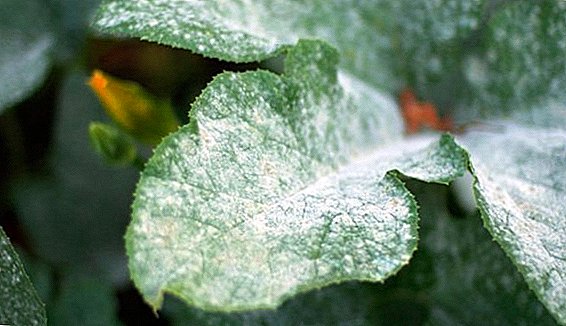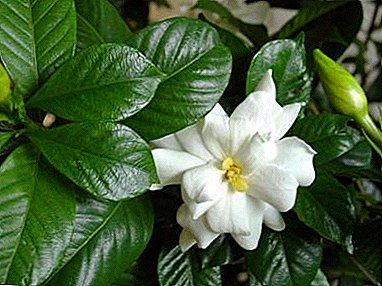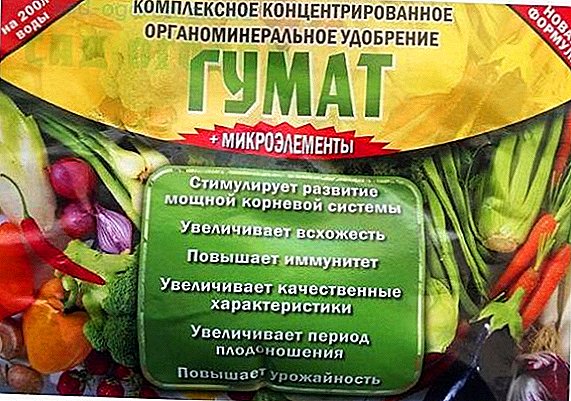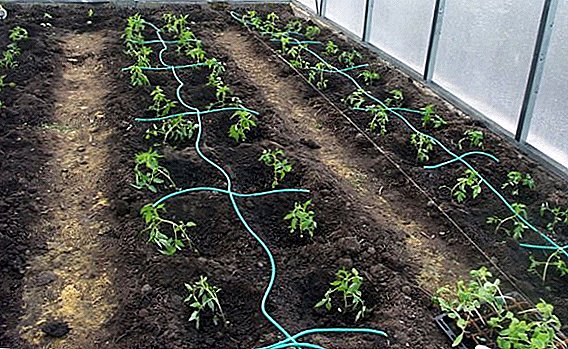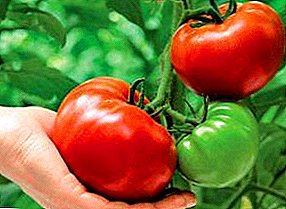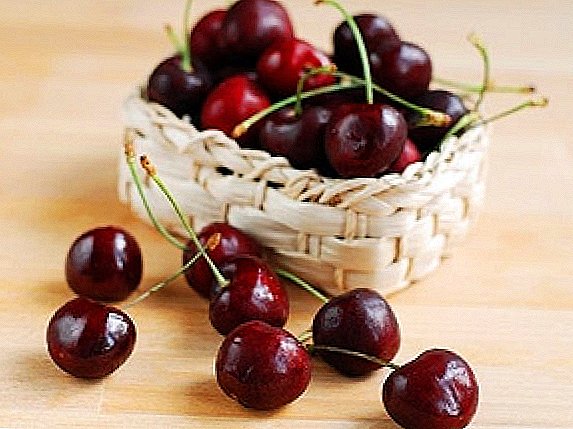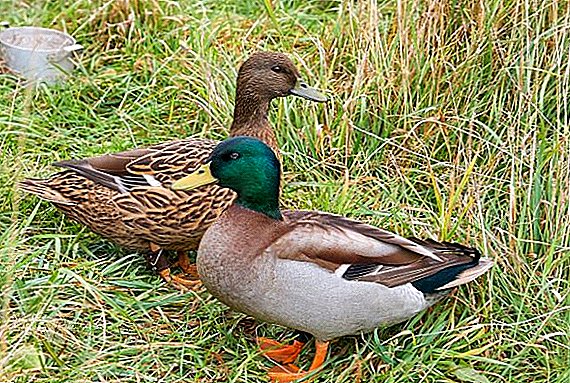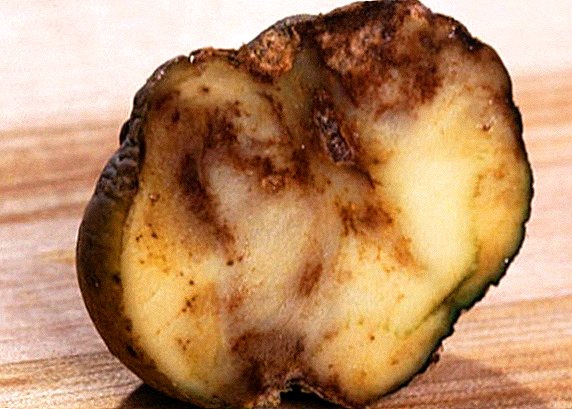 In addition to pests, potato plantations are also plagued by various diseases. Some pathogens have become much more stable over the past few years, and this is causing concern among gardeners. Meanwhile, there is no reason for panic - if you know how the phytophthora manifests itself in potatoes and how to fight it, you can save the harvest.
In addition to pests, potato plantations are also plagued by various diseases. Some pathogens have become much more stable over the past few years, and this is causing concern among gardeners. Meanwhile, there is no reason for panic - if you know how the phytophthora manifests itself in potatoes and how to fight it, you can save the harvest.
Causes and symptoms of the disease
The causative agent of the disease is the pathogen of the same name. It is among the lower fungi (oomycetes).
The disease is transmitted through phytospores, which are washed from the land part of the plant and through the soil capillaries fall on the stem or tubers. The incubation period is from 3 to 16 days. On weakened soils or in the presence of microorganisms in the planting material, the fungus progresses very quickly, in 3-4 days.

Tubers often fall ill during harvest. If the diseased tops in contact with their eyes, then part of the crop may die. With incisions, this risk increases significantly.
Important! An important preventive factor is crop rotation. If the same solanaceous crops grow at the same place from year to year, the soil should be decontaminated with Bordeaux liquid.Phytophthora as a viral mushroom loves moisture very much. A few rainy days at a temperature of 15 to 25 ° C are ideal conditions for it. Heap planting only enhances the effect: in such cases even thick dew is sufficient. In hot weather, this disease ceases to develop, but this is not easier for plants.
In most regions, it is possible to see characteristic lesions of the stem or potato leaves in the second half of summer, although in the southern regions for early varieties a few June rains are enough.

The danger is that even from several infected phytospore bushes in 1.5-2 weeks can spread to all plantations, and if not to take measures, then in 17-20 days the plants die.
Late blight is a dangerous disease for the whole Solanaceae family: tomatoes, eggplant, pepper. In addition, this disease affects strawberries, raspberries, castor oil, buckwheat.
Recognize the effect of the fungus can be on such grounds:
- spots appear on the edges of the leaves, which very quickly turn brown and increase in size;
- white markings are visible on the bottom plate of the sheet - this is the dispute;
- in rainy weather the leaf may rot;
- on the affected tubers, gray specks are clearly marked, which are also beginning to acquire a brown color. They immediately harden and deepen into the fetus. If you cut a potato, it seems that it is "rusty."
Did you know? In some parts of South America, there still is a wild potato. True, it is no good for food, as the tubers contain poisonous solanine compounds.
How to carry out the treatment (chemicals)
To ensure the harvest, will have to engage in the prevention of seed, tillage and plantations.
Disease prevention
The main thing is to use well-kept soil and healthy potatoes for planting.
As for the soil, it is desirable to choose a flat area. The field in the valley will not work - places with a large accumulation of moisture, as we remember, are potentially dangerous. The land should be well lit and ventilated, and normal drainage will have to be provided.
Recall what grew on the site earlier - winter crops, beets, flax, corn and perennial herbs will be the best predecessors. The best "neighbors" will be radish or mustard, but pepper, eggplant and other nightshade are best kept away.

Important! It is believed that severe frosts kill phytophthora in the soil. Unfortunately, the pathogen is slowly adjusting to our conditions. - for example, in the southern regions, winter is not terrible for him anymore, and it is desirable to carry out tillage since autumn.
The fight against potato blight begins even before planting into the ground and at first comes down to choosing healthy tubers. Check them simply: for 2 weeks, potatoes are heated in the open air at 15-18 ° C. Already at this stage the first signs like spots will be visible. This material is better to put aside or immediately throw away.
Further Prevention includes such measures:
- Primary treatment with potassium-phosphorus compounds in higher doses. At the same time, the concentration of potassium compounds is doubled, whereas phosphorous preparations give 1.5 times more than the norm.
- Deep planting "seed" potatoes and hilling young bushes.
- Grooves pour a hose, not a "drop".
- Cleaning sick plants growing on the site.
- Many about a week before picking just cut the tops. True, even for strong bushes it is traumatic, and it is not worth delaying with cleaning.
- Crop harvested in a sunny, dry weather. Moisture only "on hand" harmful fungus.
Potato treatment
Late blight in the active stage can not be cured. This is true, but the focus of the disease can always be "localized", not allowing disputes to spread to healthy bushes. Various solutions and preparations help in this.
Did you know? In the XVIII century, potatoes were considered "earth apple". In 1758, the Academy of Sciences in St. Petersburg even published an article devoted to its cultivation, and there is indicated such a name.
After planting, waiting for the tops to grow to 25-30 cm. This is the best time for the first treatment. In the course are the "factory" system tools like "Ridomila".
Just before flowering sprayed "Appin". For resistant varieties in warm weather without rains, Immunocytophate, Silk and Krezacin are more suitable. If the disease is still manifested, take "Ridomil" (MC or "Gold"), as well as "Oxy". For the best effect, the treatment is repeated after 1.5-2 weeks (but always before flowering).
After 8-14 days carefully inspect the bushes. If the risk of infection remains high, take strong fungicides like "Ditan", "Revus", "Skor", "Efal". For prevention (if there is no source of infection), they are mixed by half. It should be noted that the drugs should be contact ones - the phytophthora systemic fingicide quickly gets used to it.

After flowering, "Bravo" is suitable, which is used for treating bushes with an interval of 7-10 days. As for the tubers, it helps them "Alufit."
Important! In late July and August, the beds in the evening can be covered with agrofibre, removing it after the dew has come off. This material is also used to protect against rain, which serves as a "catalyst" for phytophthora.
Rain, immediately after spraying, reduces all these efforts to nothing, so you have to do repeated processing.
In addition to these compounds, there are also growth stimulants that increase the resistance of the bushes. So, for 15 liters of water, you can take 150 ml of "Oksigumat" or 5 ml of "Ecosila".
You can grow potatoes in different ways: from seeds, before winter, under a straw. And also the Dutch potato cultivation technology is very popular.
Folk methods of struggle
Many gardeners try not to saturate the bushes with potent chemicals, resorting to popular recipes. The most effective of them are:
- Garlic infusion. 100 g of finely chopped garlic is added to 10 l of water, and then allowed to stand for a day. Then the liquid is decanted and used for spraying. Full course - a month, with an interval of no more than a week (that is, 4 approaches).
- Copper sulfate is diluted in water (2 g per 10 l) and sprayed with an interval of 10 days.
- It is not inferior to him and a weak solution of potassium permanganate, boric acid and vitriol. At 3.3 liters of boiling water in individual containers take a tablespoon of these ingredients. Allowing the mixture to cool, all poured into a 10-liter container. Treatment is done twice, at the very end of July - the first of August (with a break of 7-10 days).
- Also, 10 g of water can make 20 g of copper sulfate.
- Homemade Bordeaux liquid. At 5 liters of warm water take 100 g of copper sulfate. In a separate container, quicklime is prepared in the same proportion, after which everything is “mixed”. This is a universal remedy that is suitable for all cultures as a preventive measure.
- Copper oxychloride will help - 60 g per bucket in 15 l. Such spraying is done by 3-4 approaches, with a maximum gap of a week.
Soda also helps get rid of phytophthora. It is part of the homemade fungicide. Taking 1 tablespoon of soda and 3 spoons of vegetable oil, they are dissolved in 5 liters of water, then add 1 teaspoon of liquid soap. All this is mixed and immediately applied to the site.
Did you know? Root crop was not immediately adopted in Russia - On the decision of the authorities to increase the plantings of potatoes in the middle of the XIX century, a wave of "potato riots" swept the country. But gradually they got used to it, and by the beginning of the twentieth century, the potato became known as the “second bread”.
You can fight this disease with the help of “sour milk”: 1 l of sour kefir is poured into water (10 l), stirred and insisted for 3-4 hours. After straining the mixture is ready. Use it with a week break until all the spores and blemishes disappear.
Important! To avoid overmoistening the air, the floors in the cellar are covered with gravel or pebbles. But the claydite does not give such an effect.
Some practice mulching, but this time-consuming work requires regular presence at the dacha: if the site is visited 1-2 times a week, then there is no special meaning in it (coverage should be removed daily after the dew has disappeared). It is better to sprinkle the furrows evenly with a thin layer of lime - 1 mm will be enough.

The most resistant to late blight varieties
Even before the choice of planting material is better to choose the appropriate potatoes. There is one thing: none of the varieties have a complete guarantee of preservation - different lines differ only in resistance to the disease. Of course, we need the most sustainable. These are varieties:
- "Nevsky" - flat oblong tubers with a clean white "gut" are perfect for different dishes;
- “Spring” is a favorite of many super early varieties with good immunity and enviable taste;
- "Good luck" - mid-season line, which has a long shelf life without losing its qualities;
- "Red Scarlett" - a long red root vegetable is almost immune to the action of phytophthora and well preserved.
Did you know? Potatoes can be called a cosmic culture. In 1995, she became the first "garden" species, which grew in orbit.
In this regard, early varieties are considered more profitable: the phytophtora simply does not have time to ripen, and the crop can be removed with almost no losses. With later plantings there is more work, especially as new non-standard strains appear every season.

Potato storage rules
Harvested in dry weather, potatoes are dried and sorted. Leave whole roots without processes. In this case, damaged tubers are set aside separately, they will have to be thrown away.
Most often, potatoes are stored in the basement. There, it is desirable to do the cleaning, paying special attention to the old tubers and processes - an infected potato will be a bad neighbor for a new crop. The cellar itself must be well ventilated.
You shouldn’t neglect whitewashing the walls either, especially since it’s easy to do: just take 10 liters of water, 2 kg of slaked lime and 1 kg of copper sulphate - and the mixture is ready. Some also add 150 g of regular salt.
Important! To save the crop, try not to abuse the lighting. Light activates the production of poisonous solanine in the roots.
No less important is the role of the container. In most cases, these are boxes. They are dried, it will be useful and processing of potassium permanganate. Already filled boxes are arranged so that between them there is a gap of 10 cm, and up to 25 cm to the wall. They are placed on a small (20-25 cm) elevation of planks or bricks, but so that there is enough space from the top for ceiling. Deaf drawers will not fit: between the slats you need a gap for ventilation of 2-3 cm.

Grids, in turn, provide ventilation, and burlap retains heat.
During storage, try to follow these rules:
- observance of temperature;
- insulation during long frosts; straw is best, but old warm clothes will also fit;
- periodic inspection of the container and the potato itself;
- it is desirable to move the boxes closer to spring with thaws (water often penetrates into the basements, which leads to the death of root crops).
Did you know? The importance of this culture is indicated by the fact that a special UN commission called 2008 the year of the potato.
We learned that late blight in potatoes, got a description of this disease and led the main methods with which treatment is associated. We hope this knowledge will be useful to our readers. Good luck on the beds!


